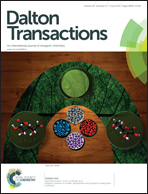A general route to monoorganopnicogen(iii) (M = Sb, Bi) compounds with a pincer (N,C,N) group and oxo ligands†‡
Abstract
The reaction of RMCl2 [R = 2,6-[MeN(CH2CH2)2NCH2]2C6H3; M = Sb (1), Bi (2)] with KOH affords the isolation of the oxides cyclo-R2M2O2 [M = Sb (3), Bi (4)]. Treatment of 3 with trifluoroacetic acid produced an ionic species (5) with a dinuclear cation that contains organic ligands protonated partially at one of the pendant arms. The cyclic oxides 3 and 4 are able to trap gaseous CO2 to give “RMCO3” [M = Sb (6), Bi (7)], the degree of these organometallic carbonates’ oligomerization being under investigation. The reactivity of the dinuclear oxide 3 was also investigated towards oxalic acid or dopamine hydrochloride and pure mononuclear compounds could be isolated, i.e. RSb[O(O)CC(O)O] (8) and RSb[O2-1,2-C6H3-3-(CH2)2NH3]Cl (9). The reaction of the dichlorides 1 and 2 with ethylene glycol, pinacol or catechol, in the presence of KOH, led to 2-organo-1,3,2-dioxastibolanes or -bismolanes RM(OCH2)2 [M = Sb (10), Bi (11)], RM(OCMe2)2 [M = Sb (12), Bi (13)] and 2-organo-1,3,2-dioxastibole or -bismole RM(O2-1,2-C6H4) [M = Sb (14), Bi (15)], respectively. The compounds were investigated by NMR spectroscopy, including variable temperature experiments, providing evidence for the presence of the intramolecular N→M interactions in solution. Single crystal X-ray diffraction studies were performed for most compounds and revealed an organic group R acting as a pincer ligand resulting in a distorted square pyramidal (N,C,N)MO2 core with cis intramolecular N→M interactions placed trans to M–O bonds. This is in contrast to the N→M interactions trans to each other as found in the RMCl2 used as starting materials. The crystals of the oxides 3 and 4·4H2O contain different geometric isomers with anti and syn orientation of the M–C bonds, respectively, with respect to the planar M2O2 ring. In the supramolecular polymeric architecture established in the crystal of 4·4H2O an important finding is the experimental observation of water hexamer units with a [tetramer + 2] structure (water molecules connected to opposite corners of a square water tetramer) fixed between 1D-chains of the type (syn-R2Bi2O2·H2O)n through additional hydrogen bonds to oxygen atoms of the dinuclear organobismuth(III) moieties. Theoretical calculations were carried out on 2–6 and 8–15 in order to gain insight into the stabilization energy produced by intramolecular coordination of the pendant arms, association degrees and formation energies of the organopnicogen compounds with chelating ligands.


 Please wait while we load your content...
Please wait while we load your content...